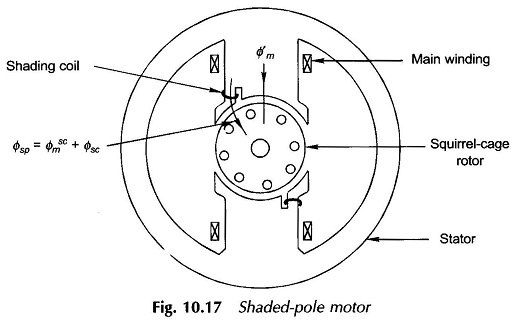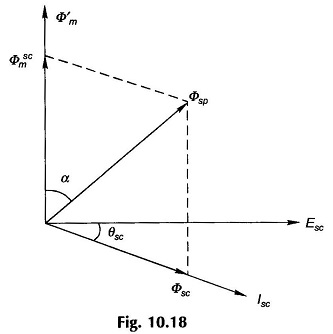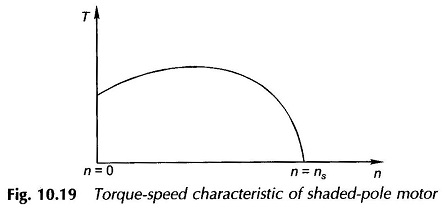Shaded Pole Motor Working Principle:
Figure 10.17 shows a typical Shaded Pole Motor with a squirrel-cage rotor. A small portion of each pole is covered with a short-circuited, single-turn copper coil called the shading coil. The sinusoidally-varying flux created by ac (single-phase) excitation of the main winding induces emf in the shading coil. As a result, induced currents flow in the shading coil producing their own flux in the shaded portion cf the pole.
Let the main winding flux be
where Φm = Φscm (flux component linking shading coil) + Φ′m (flux component passing down the air-gap of the rest of the pole)
The emf induced in the shading coil is given by
Let the impedance of the shading coil be
The current in the shading coil can then be expressed as
The flux produced by isc is
Where R = reluctance of the path of Φsc
As per Eqs (10.21) and (10.22), the shading coil current (I̅sc) and flux (Φsc) phasors lag behind the induced emf (E̅sc) by angle θsc ; while as per Eq. (10.19), the flux phasor Φ̅scm leads E̅sc by 90°. Obviously the phasor Φ̅′m is in phase with Φscm . The resultant flux in the shaded-pole is given by the phasor sum
as shown in Fig. 10.18 and lags the flux Φ̅′m of the remaining pole by angle α.
The two sinusoidally varying fluxes Φ̅′m and Φ̅′sp are displaced in space as well as have a time phase difference (α) thereby producing forward and backward rotating fields which create a net torque.
A typical torque-speed characteristic of Shaded Pole Motor is shown in Fig. 10.19. It may be seen that the motor is self-starting unlike a single-winding, single-phase motor.
It is seen from the phasor diagram of Fig. 10.18 that the net flux in the shaded portion of the pole (Φ̅sp) lags the flux (Φ̅′m ) in the unshaded portion of the pole resulting in a net torque which causes the rotor to rotate from the unshaded to the shaded portion of the pole. The motor thus has a definite direction of rotation which cannot be reversed.
The fact that the Shaded Pole Motor is single-winding (no auxiliary winding), self-starting motor makes it less costly and results in rugged construction. The motor has low efficiency and low power factor and is usually available in a range of 1/300 to 1/20 kW. It is used for domestic fans, record players and tape recorders, humidifiers, slide projectors, small business machines, etc. The shaded pole motor working principle is used in starting electric clocks and other single-phase synchronous timing motors.





